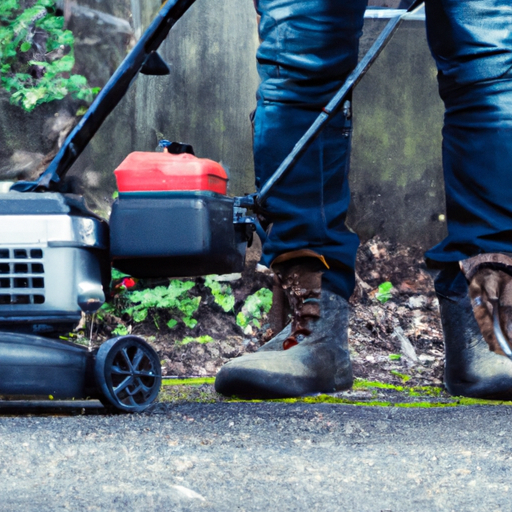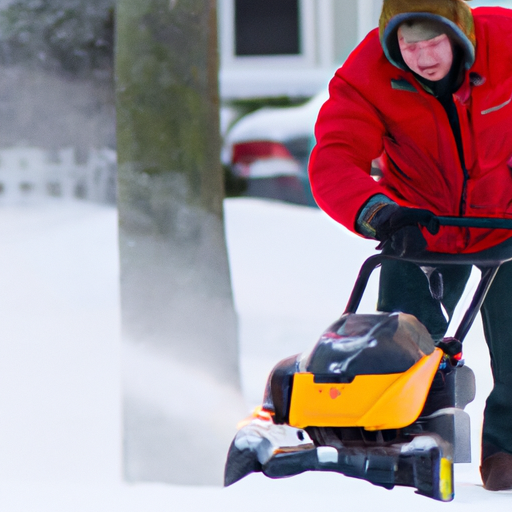Have you ever wondered how to safely operate a battery-powered leaf blower? Well, you’re in luck because we’re here to give you all the tips and tricks you need to know! Whether you’re a seasoned leaf blower user or a first-timer, it’s essential to use this tool correctly to ensure your safety and the safety of those around you. In this article, we’ll cover everything from preparing your leaf blower for use to proper handling techniques, so you can confidently tackle those fall cleanup tasks.
First, let’s talk about preparing your battery-powered leaf blower for use. Before you start blowing leaves, it’s crucial to check the battery’s charge and ensure it’s fully charged or has enough power for the task at hand. This will prevent any unexpected shut-offs while you’re in the middle of your work. Additionally, make sure to inspect the blower for any damage or loose parts that may affect its performance or safety.
Now that your leaf blower is ready, let’s move on to proper handling techniques. When operating a battery-powered leaf blower, it’s important to hold it with both hands and maintain a firm grip at all times. This not only gives you better control over the blower but also helps reduce strain on your wrists and arms. Remember to aim the nozzle away from yourself and others to prevent any debris or dust from being blown towards you.
In the next section, we’ll go into more detail about the safety precautions you should take while using a battery-powered leaf blower. So stay tuned to learn more about how to safely operate this powerful tool!
Preparing for Operation
Before using a battery-powered leaf blower, it is essential to prepare yourself and the equipment. Here are the steps you should take:
Checking the battery level
The first thing you should do is check the battery level. Make sure it is sufficiently charged to avoid any interruptions during operation. If the battery level is low, connect the blower to its charger and wait until it reaches the recommended charging level.
Inspecting the blower for any damage
Next, inspect the leaf blower for any visible damage. Check the blower tube, nozzle, and other parts for cracks or signs of wear and tear. It is important to ensure that the blower is in good condition before using it to prevent any accidents or malfunctions.
Putting on appropriate safety gear
Before using the leaf blower, it is crucial to protect yourself by wearing the appropriate safety gear. This includes safety goggles or glasses to shield your eyes from debris and dust, ear protection to prevent hearing damage from the blower’s noise, and a dust mask to filter out any airborne particles. Additionally, wearing comfortable and sturdy footwear is recommended to provide support and prevent any potential injuries.
Understanding the Controls
To operate a battery-powered leaf blower efficiently, it is essential to familiarize yourself with its controls. Here’s what you need to know:
Familiarizing yourself with the power switch
The power switch is typically located near the handle of the leaf blower. Before operating the blower, make sure you are familiar with the position and functioning of the power switch. This switch controls the blower’s on and off functions, allowing you to start and stop the blower as needed.
Getting to know the variable speed control
Most battery-powered leaf blowers come with a variable speed control feature. This allows you to adjust the blower’s blowing power according to your needs. Familiarize yourself with how the variable speed control works and practice adjusting it to find the optimal blowing speed for different tasks.
Understanding the trigger lock feature
Some leaf blowers also have a trigger lock feature. This feature allows you to lock the trigger in place, eliminating the need to continuously press it while operating the blower. Understand how the trigger lock works and when it is appropriate to use it for extended periods of operation.

Charging and Maintaining the Battery
To ensure optimal performance and longevity of your battery-powered leaf blower, follow these guidelines for charging and maintaining the battery:
Using the correct charger for your battery
Different battery models require specific chargers. It is important to use the charger provided with your leaf blower or a compatible charger recommended by the manufacturer. Using an incorrect charger can damage the battery or lead to inefficient charging.
Ensuring a proper charging environment
When charging the battery, make sure you do so in a clean, dry, and well-ventilated area. Avoid charging the battery near flammable materials or in extreme temperatures. It is also important to keep the charging area away from the reach of children and pets.
Following battery maintenance guidelines
Regular maintenance of the battery is essential to ensure its longevity and performance. Follow the manufacturer’s guidelines for cleaning and inspecting the battery. Avoid exposing the battery to extreme temperatures, water, or physical shocks. Additionally, if you notice any signs of deterioration or damage to the battery, consult the manufacturer for appropriate actions.
Starting and Stopping the Blower
Now that you are familiar with the controls and have prepared the equipment, it’s time to start and stop the leaf blower. Follow these steps:
Activating the power switch
To start the leaf blower, locate the power switch and turn it on. Some leaf blowers may have a safety lock that needs to be pressed or released before the power switch can be activated. Ensure that you have a firm grip on the blower before turning it on.
Applying pressure to the variable speed control
Once the power switch is turned on, apply pressure to the variable speed control to adjust the blowing power. Start with a lower speed setting and gradually increase it as necessary. This allows you to have better control and prevent blowing debris in unintended directions.
Releasing the trigger to stop the blower
To stop the leaf blower, release the trigger. This will immediately halt the blowing action. Always make sure the blower has come to a complete stop before setting it down or performing any maintenance tasks.

Using the Blower Safely
Operating a leaf blower safely is crucial to prevent accidents or injuries. Here are some safety precautions to keep in mind while using a battery-powered leaf blower:
Keeping a safe distance from people and objects
When using the leaf blower, maintain a safe distance from people, pets, and valuable objects. The high speed of the air emitted from the blower can cause injury or damage if directed towards fragile or valuable items.
Avoiding blowing debris towards others
Be considerate of your surroundings and avoid blowing debris, such as leaves or dirt, towards others. This can cause discomfort and potential harm, especially when debris gets into people’s eyes or mouths. Always be mindful of the direction in which you are blowing the air.
Being cautious when using the blower in windy conditions
Using a leaf blower in windy conditions can be more challenging and potentially dangerous. The wind can affect the blower’s efficiency and change the direction of the blowing air. Exercise caution and adjust the blowing angle and speed accordingly to avoid any accidents or unintended consequences.
Avoiding Potential Hazards
To ensure your safety and the longevity of the leaf blower, it’s important to be aware of potential hazards and take appropriate precautions:
Preventing the blower from getting wet
Battery-powered leaf blowers are not designed to be used in wet or rainy conditions. Moisture can damage the blower’s electrical components and pose a risk of electric shock. If it starts raining while operating the blower, immediately stop and safely store the equipment indoors.
Being cautious of overheating
Using a leaf blower for an extended period can cause it to overheat. If you notice the blower becoming excessively hot, stop using it immediately and allow it to cool down. Continuous operation in an overheated state can lead to damage to the blower and potential injuries.
Avoiding contact with rotating parts
Many battery-powered leaf blowers have rotating parts, such as fan blades or impellers, which can cause severe injuries if touched. Keep your hands, clothing, and other objects away from these rotating parts while the blower is in operation. Always exercise caution and follow the manufacturer’s guidelines to prevent accidents.
Proper Storage and Transport
Proper storage and transport of your battery-powered leaf blower are crucial to its longevity and safety. Follow these steps:
Cleaning the blower before storing it
Before storing the leaf blower, remove any debris or dirt from its exterior. Use a soft brush or cloth to clean the blower tube, nozzle, and other parts. This prevents the accumulation of dirt and ensures that the blower is ready for the next use.
Storing the battery separately
It is recommended to store the battery separately from the leaf blower. This prevents any potential damage to the battery caused by extreme temperatures or exposure to moisture. Store the battery in a cool, dry place away from direct sunlight.
Securing the blower for transport
If you need to transport the leaf blower, make sure it is securely fastened and protected. Use the original packaging or a sturdy bag designed for transportation. Secure any loose parts or accessories and ensure that the blower is not at risk of falling or getting damaged during transportation.
Maintaining the Blower
Regular maintenance is essential to keep your battery-powered leaf blower in optimal condition. Follow these maintenance guidelines:
Regularly cleaning the air intake and outlet
Periodically clean the blower’s air intake and outlet to remove any accumulated dirt or debris. This ensures proper airflow and prevents clogging, which can affect the blower’s performance. Use a soft brush or cloth to remove any dirt gently.
Inspecting and replacing worn-out parts
Regularly inspect the blower for any signs of wear and tear. Check the blower tube, nozzle, and other parts for cracks or damage. Replace any worn-out or damaged parts to maintain the blower’s efficiency and safety.
Lubricating moving parts as necessary
To ensure smooth operation, lubricate the blower’s moving parts as recommended by the manufacturer. Use the appropriate lubricant and apply it sparingly to prevent any excess buildup or damage. Lubricating the blower’s parts regularly helps reduce friction and ensures its longevity.
Troubleshooting Common Issues
While battery-powered leaf blowers are generally reliable, you may encounter some issues from time to time. Here are some troubleshooting tips for common problems:
Blower not powering on
If the blower does not power on, check the battery level and ensure it is charged. If the battery is charged and the blower still does not turn on, inspect the power switch and electrical connections for any loose or damaged parts. If the issue persists, consult the manufacturer or an authorized service center for assistance.
Battery not charging properly
If the battery does not charge properly, ensure that you are using the correct charger for your specific battery model. Check the electrical connections and make sure they are secure. If the problem persists, try cleaning the battery contacts or consult the manufacturer for further troubleshooting steps.
Blower not achieving maximum blowing power
If the blower does not achieve maximum blowing power, check the variable speed control to ensure it is set correctly. Additionally, inspect the blower tube and nozzle for any obstructions or clogs. If the issue continues, consult the manufacturer or an authorized service center for further assistance.
Conclusion
Operating a battery-powered leaf blower can be safe and efficient when you follow the recommended practices. By familiarizing yourself with the controls, charging and maintaining the battery properly, and taking necessary safety precautions, you can enjoy the benefits of using a battery-powered leaf blower for your outdoor tasks. Regular maintenance and troubleshooting, if needed, will ensure the longevity and optimal performance of your leaf blower. Remember, safety always comes first, and by following these guidelines, you can have a pleasant and productive experience with your battery-powered leaf blower.


